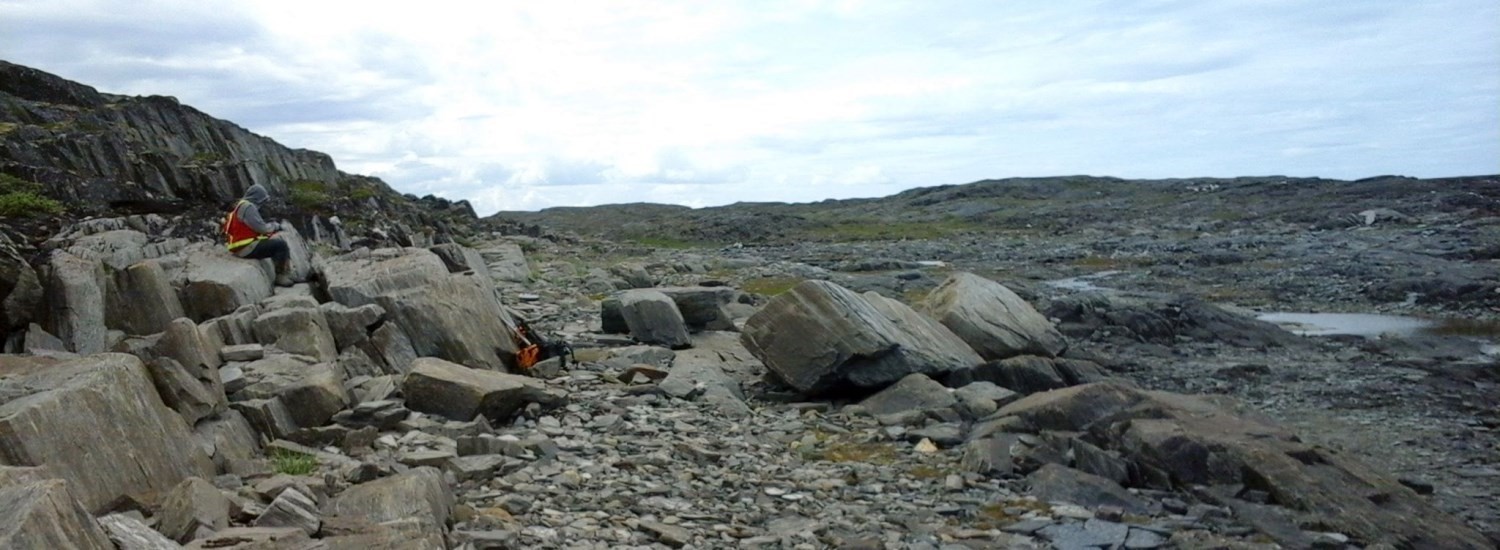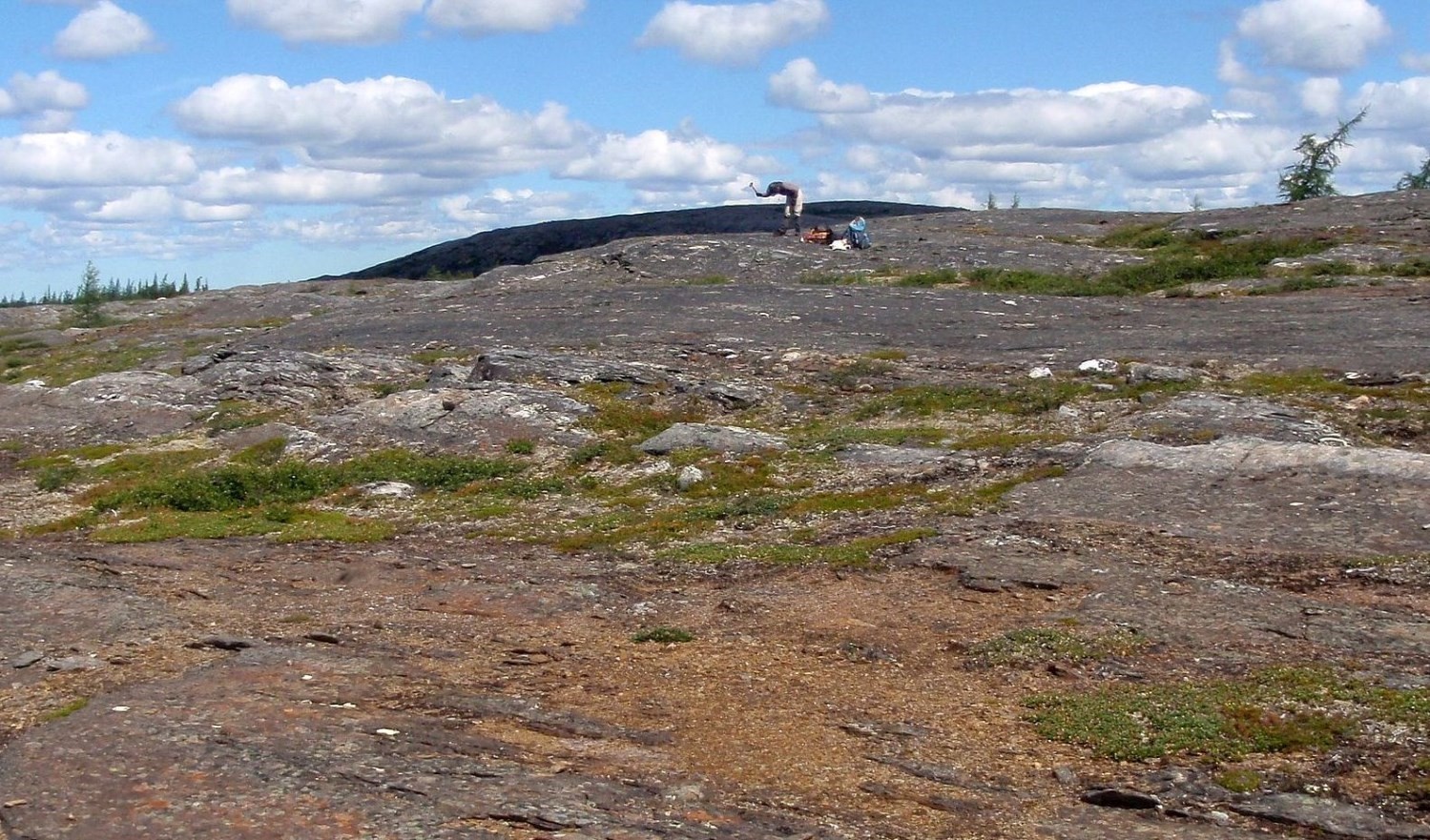
DISCLAIMER: This English version is translated from the original French. In case of any discrepancy, the French version shall prevail.
| Author(s): | Simard et al., 2013 |
| Age: | Paleoproterozoic |
| Stratotype: | None |
| Type area: | Kuujjuaq area (NTS sheet 24K) |
| Geological province: | Churchill Province |
| Geological subdivision: | Rachel-Laporte Lithotectonic Domain |
| Lithology: | Metamorphosed volcano-sedimentary rocks |
| Category: | Lithodemic |
| Rank: | Supersuite |
| Status: | Formal |
| Use: | Active |
- Laporte Supersuite
Background
In the 1940s, geologists at Labrador Mining and Exploration introduced the term “Laporte Series” to describe schists, gneiss and amphibolites located NE of Schefferville, in the Laporte Lake area (Frarey and Duffell, 1964). Harrison (1952) formalized this unit as the Laporte Group. In the southern portion of the Quebec part of the New Quebec Orogen, Baragar (1967) designated metamorphic rocks located east of the Labrador Trough as the Younger Complex, considering that metamorphism had obliterated primary structures of rocks and that the relative age of these units could not be established. However, this term was not used in subsequent work, as authors preferred the term “Laporte Group” (Frarey, 1967; Dimroth, 1978; Dressler, 1979; Fournier, 1985; Girard, 1995; Henrique-Pinto et al., 2017, 2019). In the Kuujjuaq area (sheet 24K), Goulet (1995) assigned metamorphosed rocks of the Laporte Group to the Thévenet Formation (Sauvé and Bergeron, 1965), a term that was not used in subsequent work. In the Déborah Lake area, Girard (1995) reassigned some of Laporte Group rocks to the Deborah Formation, considering that in this area, paraschists have a mappable extent, consistency, internal homogeneity and established stratigraphic position. Metamorphosed rocks of the Laporte Group were considered by various authors to be equivalent to several units of the Kaniapiskau Supergroup (Labrador Trough). The loss of the rocks’ primary textures by metamorphic recrystallization led Simard et al. (2013) to replace the term “Laporte Group” with “Laporte Supersuite”. This designation places this regional-scale unit among higher-ranking lithodemic units, equivalent to a supergroup, in accordance with the North American Stratigraphic Code (1983, 2005). The Laporte Supersuite thus combines all Paleoproterozoic metamorphosed supracrustal rocks of the Rachel-Laporte Lithotectonic Domain.
A regional compilation of the Southeastern Churchill Province (SECP) by the Ministère’s geologists in 2003 divided rocks of the Rachel-Laporte Lithotectonic Domain (pPLAP) into 14 informal units. In the Bonaventure Lake area, Hammouche et al. (2011) recognized units pPLAP1 and pPLAP5, and defined two new informal units (pPLAP15 and pPLAP16). As part of a SECP regional synthesis (Lafrance et al., 2018; Lafrance and Vanier, 2021), these informal units were abandoned and reassigned to the Freneuse, Klein or Secondon suites, depending on their composition and origin.
In the Déborah Lake area, Girard (1995) divided the Laporte Group (now Laporte Supersuite) into four lithodemic packages: the Deborah Formation, Grand Rosoy Formation, De Jeu Gabbro and Manereuille Complex. Henrique-Pinto et al. (2017, 2019) also extrapolated the Deborah and Grand Rosoy formations in the northern part of the Rachel-Laporte Domain, in the vicinity of the Feuilles Bay. However, ages obtained in the Grand Rosoy Formation (now redefined as the Grand Rosoy Suite) has allowed including within the Baleine Lithotectonic Domain (Lafrance et al., 2020). Located to the east of the Grand Rosoy Suite, units of the Maneureuille Complex (abandoned) were also reassigned to those of the Baleine Domain (Akiasirviup, Curot or Ralleau suites). As for the Deborah Formation and the De Jeu Gabbro, they were respectively reassigned to the Freneuse and Klein suites depending on their composition.
The Préville and Secondon suites were rather introduced in the Jeannin Lake area (Charette et al., 2016).
Description
The Laporte Supersuite was divided into two suites by Simard et al. (2013): the Klein Suite, which includes metamorphosed mafic and ultramafic rocks of effusive or intrusive origin, and the Freneuse Suite, which groups most metasedimentary rocks. Rocks of these two suites commonly contain rusty layers mineralized in sulphides (Lafrance and Vanier, 2021). In the Jeannin Lake area, Charette et al. (2016) added the Préville Suite to group mafic calcosilicate rocks and carbonate gneiss, and the Secondon Suite that consists of meta-arkose and paraschist.
Thickness and distribution
The Laporte Supersuite, which covers ~11 660 km2, is the dominant unit of the Rachel-Laporte Lithotectonic Domain, representing close to 85% of its area. It is ~550 km long and 20 km to 35 km wide, and is generally oriented NNW-SSE. It is adjacent to the eastern limit of the Labrador Trough.
Dating
The age distribution of detrital zircons recovered from the Freneuse Suite ranges from 3226 Ma to 1830 Ma (Henrique-Pinto et al., 2017; Godet et al., 2020). Paleoproterozoic and Archean population peaks are interpreted to indicate provenance from different lithotectonic domains of the SEPC, namely the George, Baleine and Mistinibi-Raude domains (Henrique-Pinto et al., 2017, 2019). The sediments’ depositional age is fairly well constrained between 1834 Ma (age of the youngest detrital zircons) and 1804 Ma (age of garnet growth).
Stratigraphic Relationship(s)
The Laporte Supersuite almost covers the entire Rachel-Laporte Lithotectonic Domain. It is limited to the west and east by thrust faults. It is also in fault contact with various Archean or Proterozoic structural complexes that are, north to south: the Boulder, Rénia, Highfall, Boullé and Wheeler complexes (Simard et al., 2013; Lafrance et al., 2014; Charette et al., 2016). These complexes correspond to tectonic slices that overthrusted Paleoproterozoic rocks during the New Quebec Orogenesis..
Volcano-sedimentary units of the Laporte Supersuite are locally intruded by dykes or sills of granite and pegmatitic felsic rocks of the Mercier Suite.
Several authors have proposed that rocks of the Laporte Supersuite are largely equivalent to those of the Kaniapiscau Supergroup in the Labrador Trough (Harrison, 1952; Gélinas, 1958a, b; Sauvé and Bergeron, 1965; Simard et al., 2013). However, significant differences between detrital zircon populations of these two lithotectonic domains indicate different sources (Henrique-Pinto et al., 2017; Godet et al., 2020), confirming the hypothesis of Charette et al. (2016) who questioned this equivalence based on the apparent thickness and composition of metasedimentary rocks of the two domains.
In the northern part of the Rachel-Laporte Domain, Henrique-Pinto et al. (2017, 2019) interpreted the evolution of the depositional environment through time. A first cycle would be related to the deposition of conglomerate and arkose in a continental forearc basin context. A second cycle would be associated with the deposition of feldspathic wacke within a continental foreland basin.
Paleontology
Does not apply.
References
Publications Available Through SIGÉOM Examine
CHARETTE, B., LAFRANCE, I., MATHIEU, G., 2016. Géologie de la région du lac Jeannin, Québec, Canada. MERN; BG 2015-01, 1 plan.
DIMROTH, E., 1978. Région de la fosse du Labrador entre les latitudes 54° 30′ et 56° 30′. MRN; RG 193, 417 pages, 16 plans.
DRESSLER, B., CIESIELSKI, A., 1979. Région de la fosse du Labrador. MRN; RG 195, 136 pages, 14 plans.
FOURNIER, D., 1985. MINERALISATION DE LA PARTIE ORIENTALE DU GEOSYNCLINAL DU LABRADOR (GROUPE DE LAPORTE). MRN; ET 83-23, 57 pages, 4 plans.
GELINAS, L., 1958. RAPPORT PRELIMINAIRE SUR LA REGION DU LAC GABRIEL (PARTIE OUEST), NOUVEAU-QUEBEC. MRN; RP 373, 13 pages, 1 plan.
GELINAS, L., 1958. RAPPORT PRELIMINAIRE SUR LA REGION DU LAC THEVENET (MOITIE EST), NOUVEAU-QUEBEC. MRN; RP 363, 11 pages, 1 plan.
GIRARD, R., 1995. GEOLOGIE DE LA REGION DU LAC DEBORAH, TERRITOIRE-DU-NOUVEAU-QUEBEC. MRN; MB 95-20, 186 pages, 3 plans.
GOULET, N., 1995. ETUDE STRUCTURALE, STRATIGRAPHIQUE ET GEOCHRONOLOGIQUE DE LA PARTIE NORD DE LA FOSSE DU LABRADOR. MRN; MB 95-36, 41 pages, 1 plan.
HAMMOUCHE, H., LEGOUIX, C., GOUTIER, J., DION, C., PETRELLA, L., 2011. GEOLOGIE DE LA REGION DU LAC BONAVENTURE. MRNF; RG 2011-03, 37 pages, 1 plan.
LAFRANCE, I., CHARETTE, B., VANIER, M-A., 2018. Sud-est de la Province de Churchill, Nunavik, Québec, Canada : synthèse de la géologie. MERN; BG 2018-12
LAFRANCE, I., SIMARD, M., BANDYAYERA, D., 2014. GEOLOGIE DE LA REGION DU LAC SAFFRAY (SNRC 24F, 24G). MRN; RG 2014-02, 51 pages, 1 plan.
LAFRANCE, I., VANIER, M.-A. 2021. DOMAINE LITHOTECTONIQUE DE RACHEL-LAPORTE, SUD-EST DE LA PROVINCE DE CHURCHILL, QUÉBEC, CANADA : SYNTHÈSE DE LA GÉOLOGIE. MERN; BG 2021-01, 1 plan.
LAFRANCE, I., VANIER, M-A., CHARETTE, B., 2020. Domaine lithotectonique de Baleine, sud-est de la Province de Churchill, Québec, Canada : synthèse de la géologie. MERN; BG 2020-07, 4 plans.
SAUVE, P., BERGERON, R., 1965. REGION DES LACS GERIDO ET THEVENET, NOUVEAU-QUEBEC. MRN; RG 104, 141 pages, 3 plans.
SAUVE, P., BERGERON, R., 1965. GERIDO LAKE – THEVENET LAKE AREA, NEW QUEBEC. MRN; RG 104(A), 131 pages, 3 plans.
SIMARD, M., LAFRANCE, I., HAMMOUCHE, H., LEGOUIX, C., 2013. GEOLOGIE DE LA REGION DE KUUJJUAQ ET DE LA BAIE D’UNGAVA (SNRC 24J, 24K). MRN; RG 2013-04, 62 pages, 1 plan.
Other Publications
BARAGAR, W.R.A., 1967. Wakuach Lake map-area, Quebec-Labarador (23 O). Geological Survey of Canada; Memoir 344, 174 pages. doi.org/10.4095/123960
FRAREY, M.J., 1967. Willbob Lake and Thompson Lake map-areas, Quebec and Newfoundland (23 0/1 and 23 O/8). Geological Survey of Canada; Memoir 348, 73 pages. doi.org/10.4095/123896
FRAREY, M.J., DUFFELL, S., 1964. Revised stratigraphic nomenclature for the central part of the Labrador Trough. Geological Survey of Canada; Paper 64-25, 13 pages. doi.org/10.4095/123909
GODET, A., GUILMETTE, C., LABROUSSE, L., DAVIS, D.W., VANIER, M.-A., LAFRANCE, I., CHARETTE, B., 2020. Contrasting P-T-t paths reveal a metamorphic discontinuity in the New Quebec Orogen: insights into Paleoproterozoic orogenic processes. Precambrian Research, page 105675. doi.org/10.1016/j.precamres.2020.105675
HARRISON, J.M., 1952. The Quebec-Labrador iron belt, Quebec and Newfoundland. Geological Survey of Canada; Paper 52-20, 21 pages. doi.org/10.4095/123923
HENRIQUE-PINTO, R., GUILMETTE, C., BILODEAU, C., McNICOLL, V., 2017. Evidence for transition from a continental forearc to a collisional pro-foreland basin in the eastern Trans-Hudson Orogen: Detrital zircon provenance analysis in the Labrador Trough, Canada. Precambrian Research, volume 296, pages 181-194. doi.org/10.1016/j.precamres.2017.04.035
HENRIQUE-PINTO, R., GUILMETTE, C., BILODEAU, C., STEVENSON, R., CARVALHO, B.B., 2019. Petrography, geochemistry, and Nd isotope systematics of metaconglomerates and matrix-rich metasedimentary rocks: implications for the provenance and tectonic setting of the Labrador Trough, Canada. Canadian Journal of Earth Sciences, volume 56, pages 672-687. doi.org/10.1139/cjes-2018-0187
Suggested Citation
Ministère de l’Énergie et des Ressources naturelles (MERN). Laporte Supersuite. Quebec Stratigraphic Lexicon. https://gq.mines.gouv.qc.ca/lexique-stratigraphique/province-de-churchill/supersuite-de-laporte_en [accessed on Day Month Year].
Contributors
|
First publication |
Isabelle Lafrance, P. Geo., M.Sc. isabelle.lafrance@mern.gouv.qc.ca (redaction) Mona Baker, P. Geo., M.Sc. (coordination); Thomas Clark, P. Geo., Ph.D. and James Moorhead, P. Geo., M.Sc. (critical review); Pierre Lacoste, P. Geo., M.Sc. (editing); Céline Dupuis, P. Geo., Ph.D. (English version); Caroline Thorn (HTML editing). |
|
Revision(s) |
Isabelle Lafrance, P. Geo., M.Sc. isabelle.lafrance@mern.gouv.qc.ca; Marc-Antoine Vanier, Jr. Eng., M.Sc. marc-antoine.vanier@mern.gouv.qc.ca (redaction) Mehdi A. Guemache, P. Geo., Ph.D. (coordination); Carl Bilodeau, P. Geo., M.Sc. (critical review); Simon Auclair, P. Geo., M.Sc. (editing); Céline Dupuis, P. Geo., Ph.D. (English version); André Tremblay (HTML editing). |



